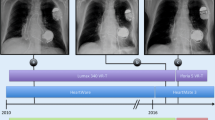Abstract
The evolution of diagnostic information provided in implantable cardioverter defibrillators (ICDs) has paralleled the advances in the therapeutic options incorporated in these systems. Contemporary devices are capable of providing recordings of electrical events surrounding all delivered and aborted device therapy. This report presents un unusual case of inappropriate discharge of an ICD, resulting from electromagnetic interference. A transvenous ICD system (Sentry Hot Can 4310 HC, Telectronics Denver, CO), was implanted in a patient with ischemic heart disease due to episodes of ventricular tachycardia refractory to antiarrhythmic treatment. One month post-implant the patient reported two consecutive shocks from the device while showering. The non-physiological cycle length (100ms) recorded in conjunction to the scenario of the event, raised the suspicion of electromagnetic interference through electrical current leakage in the bathroom, an hypothesis that was subsequently proved. This case report underscores that electromagnetic interference can become hazardous in common daily activities of patients with an ICD.
Similar content being viewed by others
References
Marchlinski FE, Kleinman RB, Hook BG, et al. Advances in implantable cardioverter defibrillator therapy. In: Josephson ME, Wellens HJJ (Eds): Tachycardias: Mechanisms and managements. Mt Kisco, NY, Futura Publishing Co., Inc., 1993, pp 405-420.
Marchlinski FE, Gottlieb CD, Sarter B, et al. ICD Data storage: Value in arrhythmia management. PACE 1993;16:527–534.
Hook BG, Marchlinski FE. The value of ventricular electrogram recordings in the diagnosis of arrhythmias precipitating electrical device therapy. J. Am. Coll. Cardiol. 1991;17:985–990.
Snadler MT, Kutalek SP. Inappropriate discharge by an implantable cardioverter defibrillator: Recognition of unipotential sensing using telemetered intracardiac electrograms. PACE 1994;17:665–671.
Rosenqvist M, Beyer T, Block M, et al. Adverse events with transvenous implantable cardioverter defibrillators. A prospective multicenter study. Circulation 1998;98:663–670.
Ruppel R, Schluter C, Boczor S, et al. Ventricular tachycardia during follow-up in patients resuscitated from ventricular fibrillation: Experience from stored electrograms of implantable cardioverter defibrillators. J. Am. Coll. Cardiol. 1998;32:1724–1730.
Callans DJ, Hook BG, Kleinman RB, et al. Unique sensing errors in third generation implantable cardioverter defibrillators. J. Am. Coll. Cardiol. 1993;22: 1135–1140.
Callans DJ, Hook BG, Marchlinski FE. Paced beats following single nonsensed complexed in a co-dependent'' cardioverter/defibrillator and bradycardia pacing system: potential for ventricular tachycardia induction. PACE 1991;14:1281–1287.
Hurwitz JL, Hook BG, Flores BT, et al. Importance of abortive shock capability with electrogram storage in cardioverter defibrillator devices. J. Am. Coll. Cardiol. 1993;21:895–900.
Marchlinski FE, Gottlieb CD, Schwartzman DS, et al. Electrical events associated with ventricular tachycardia initiation and their prevention. In: Zipes and Zalife (Eds): Cardiac Electrophysiology: From Cell to Bedside. 2nd edition Philadelphia WB Saunders Co. 1994.
Madrid A, Sanchez A, Bosch E, et al. Dysfunction of implantable defibrillators caused by slot machines. PACE 1997;20:212–214.
Echt DS. Potential hazards of implanted devices for the electrical control of tachyarrhythmias. PACE 1984;7:1345.
Peters R, Cooklin M, Brockman R, et al. Inappropriate shocks from implanted cardioverter defibrillators caused by sensing of diaphragmatic myopotentials. Journal of Interventional Cardiac Elect 1998;2:367–370.
Sentry Hot Can 4310 HC. Physician's Manual Telectronics Pty Limited, Lane Cove Australia 1995; pp: 40–41.
Author information
Authors and Affiliations
Rights and permissions
About this article
Cite this article
Manolis, A.G., Katsivas, A.G., Vassilopoulos, C.V. et al. Implantable Cardioverter Defibrillator—An Unusual Case of Inappropriate Discharge During Showering. J Interv Card Electrophysiol 4, 265–268 (2000). https://doi.org/10.1023/A:1009834100540
Issue Date:
DOI: https://doi.org/10.1023/A:1009834100540




